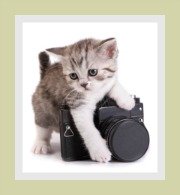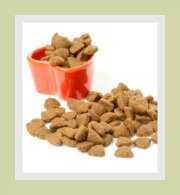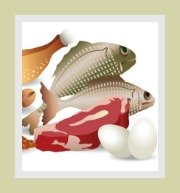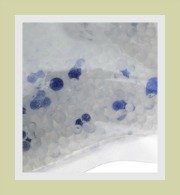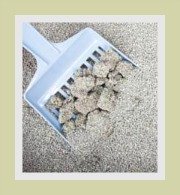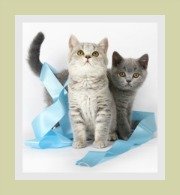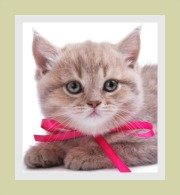Cat Food Bowls
Dishes Cats Prefer
The information on cat food bowls contained on this page also refers to cat bowls intended for use as cat water bowls.
Cat feeding dishes are one of the first items potential cat owners rush out and purchase when expecting the arrival of their new kitten or cat.
Purchasing the right dish is as important as buying the right cat food. If a cat refuses to eat from a specific cat bowl it can become an expensive exercise finding the right dish for a fussy cat!
selecting the right cat food bowl
There are a plethora of cat bowls to choose from, the question that you need to ask yourself is 'which cat bowl will suit my cat best ' (not you).
You may want to purchase a cat feeding dish that is aesthetically appealing, or one that fits your decor - you can do this provided that your cat loves it, that it's safe and that it conforms to these basic requirements:
1. cat food bowls need to be size and age appropriate
- A kitten will require a small, shallow cat bowl that holds sufficient cat food for one meal.
- Adult cats require a larger, slightly deeper cat bowl. The cat feeding dish should be large enough and shallow enough to ensure that the cat's whiskers do not touch the side of the bowl when feeding.
-
In each case the cat feeding bowl should be large enough for a
single meal but not too large as to encourage over-feeding.
2. cat bowls need to be cat and cat breed appropriate
- A flat- faced Persian needs a relatively flat bowl with concave sides which will assist them to scoop the cat food into their mouth.
- Larger cat breeds like the Maine Coon, Ragdoll and Norwegian Forest cat would prefer a larger bowl that accommodates their head size and prevents their whiskers from touching the sides of the bowl.
- Longhaired cats would prefer a bowl that is large enough to accommodate their cat food, but shallow enough to prevent their fur from becoming soiled.
- Messy eaters may require a slightly deeper bowl and plastic place mat to pick up any spillage.
- Cats that tend to 'attack' their food at each meal need a cat food bowl that is sturdy, strong and unbreakable.
- A bowl with a slip-proof base should also be considered.
3. feeding bowls need to be pet safe
- Cat bowls need to be manufactured from pet-safe materials that are not detrimental to the cat's health.
- Cat feeding dishes need to be made from materials that can be easily and hygienically cleaned and dishwasher-safe.
- The cat bowl should not absorb or retain odors as this will discourage the cat from using it.
- Cat bowls that emit strong chemical odors should be avoided - you cat will most certainly avoid it.
- A cat feeding dish should not easily crack or perish
under normal use. Cracks and rough surfaces can harbor bacteria which
can result in your cat or kitten becoming ill.
types of cat food bowls
1. stainless steel bowls
|
Stainless steel bowls are a good option, (not aluminum or other metals). They are durable, hygienic, easy to clean and dishwasher safe. A stainless steel cat food or water bowl will not crack or perish even if dropped. Most manufacturers produce cat dishes in a range of designs, colors, sizes, shapes and varying depths. Certain stainless steel dishes have a rubber rim on the base which prevents the dish from sliding around. Some cats do reject stainless steel cat bowls as they do have a mild
metallic taste and secondly, the shiny reflective finish may be
distracting or scary to a timid kitten. |
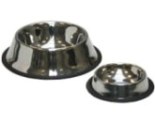 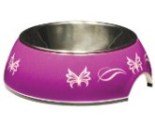 |
2. ceramic cat food bowls
|
Ceramic cat bowls are probably the most attractive and come in a wide range of designs, shapes, sizes and colors. These cat bowls are generally easy to clean, hygienic and dishwasher safe. Pottery, ceramic and terra cotta bowls are sturdy and semi-durable - they will break if dropped. They can crack and this provides the ideal breeding ground for bacteria and germs to thrive! Some ceramic cat food bowls have a high-gloss ceramic glaze or are decorated with paint which contains a highly toxic lead. Check with the manufacturer that they are pet safe, if not avoid them at
all costs! |
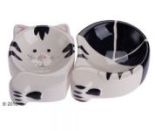 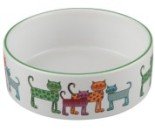 |
3. plastic cat feeding bowls
|
Plastic and melamine cat bowls are durable and easy to clean. They are lightweight which means they do tend to move around when the cat is eating. (Find one with a rubber rim on the base that prevents the bowl from moving). Plastic bowls do come in a variety of shapes, designs and colors. They are relatively inexpensive, so if you do plan on purchasing a plastic bowl, they can be replaced regularly. Plastic cat bowls do retain odors and tend to scratch and crack and this provides a perfect breeding ground for bacteria and germs that are harmful to your cat. Avoid plastic feeding bowls that have a strong chemical odor. This odor will taint the food and the cat will reject its food. We have read that plastic bowls may be the major cause of cat acne on the cat's chin. Some companies do produce heavyweight, durable plastic bowls that
last longer and have an anti-microbial coating, so look out for these
high quality bowls. |
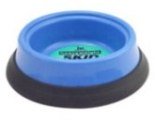 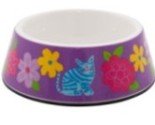 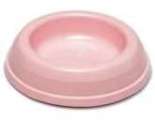 |
4. glass cat feeding bowls
|
Glass cat bowls made of a shatterproof durable glass is easy to clean, hygienic and dishwasher safe. They do not come in a wide range of designs, shapes and colors. They are sturdy but will generally break rather than crack. Glass cat bowls have the advantage that they do not retain odors or taint the food and bacterial growth is unlikely. This type of cat food bowl would probably be the one most cats prefer. |
  |
5. bio-degradable cat feeding bowls
A bowl made of biodegradable material (bamboo fibers and rice husks) is the latest addition to the cat food bowl market.
The two natural fibers are mixed with a resin that effectively bonds the fibers together creating the ideal bowl for food and water.
We believe that these bowls come in different colors and sizes, are lightweight and fairly durable
We have not seen these bowls, so cannot comment.
feeding bowl formats
1. single bowls
|
These bowls allow pet lovers to buy individual/different bowls for food and water. They are available in a range of styles, designs, colors and
materials mentioned in the above review. |
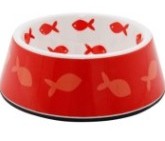 |
2. double or duo feeding bowls
|
Duo bowls consist of an attractive holder containing two bowls. The advantage of these dual feeding bowls is that one cat bowl can hold dry cat food, the other bowl water or wet cat food. Cats on an exclusive dry food diet need an increased intake of water. The dual system may encourage them to drink more water due to the close proximity of the food and water. Possibly the only disadvantage is that dry food can become wet or water can be 'contaminated with dry food, leading to food or water spoilage. Dual cat
feeding bowls come in a wide range of designs, colors and styles. |
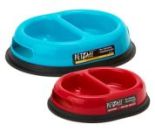 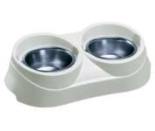 |
3. automatic cat feeders
|
Automatic cat feeders are an ideal way to feed a cat if the pet owner is away from home for a limited period. These cat feeders can be set to provide a constant supply of food at regular intervals. Whilst these feeders are ideal if you are away, you should still ensure that a pet sitter visits at least once a day. Pet sitter will ensure that the cat is in good health and that the cat feeder is in good working order (battery not flat) and that the feeding tray area of the unit is clean. An automatic cat feeder is a great invention, but it should never replace human involvement and direct contact with your cat. The cat feeder needs to be sturdy to ensure that it does not topple over. If the feeder does not have a regulator valve providing set amounts of food, it would certainly be a disadvantage to an already obese cat. The cat food reservoir part of the cat feeder must be airtight to avoid food contamination. |
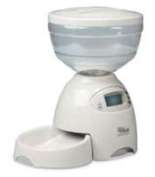 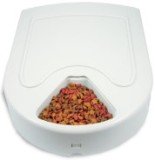 |
tips
Irrespective of your choice of cat food bowl, it must be washed daily and rinsed thoroughly to remove all detergent residue.
Damaged and perished bowls must be replaced.
If your cat is off their food, always consult with a veterinarian, it may be more than just the cat bowl or their cat food that has caused them to refuse their food.
A lack of appetite may be due to illness.
Top of Cat Food Bowls Page
search our site
please like us
share our site
recommend on google
popular pages
